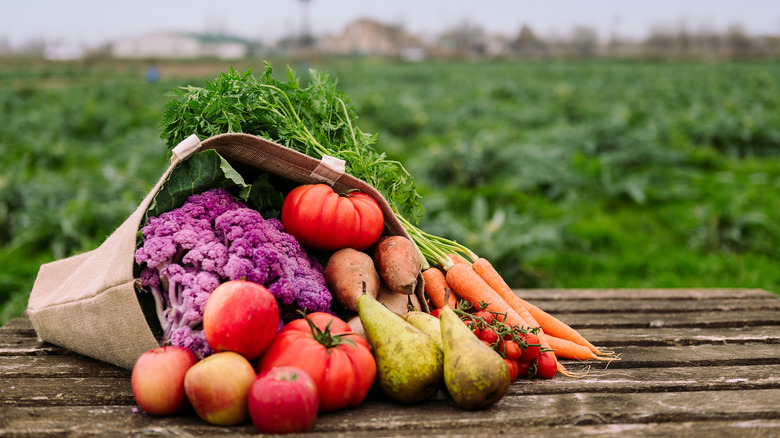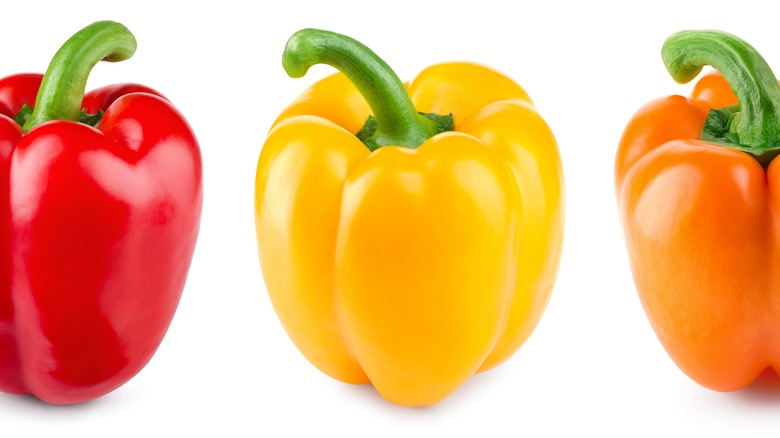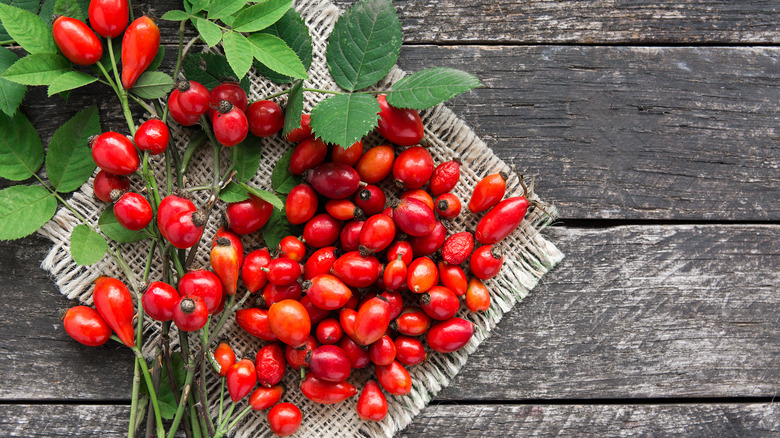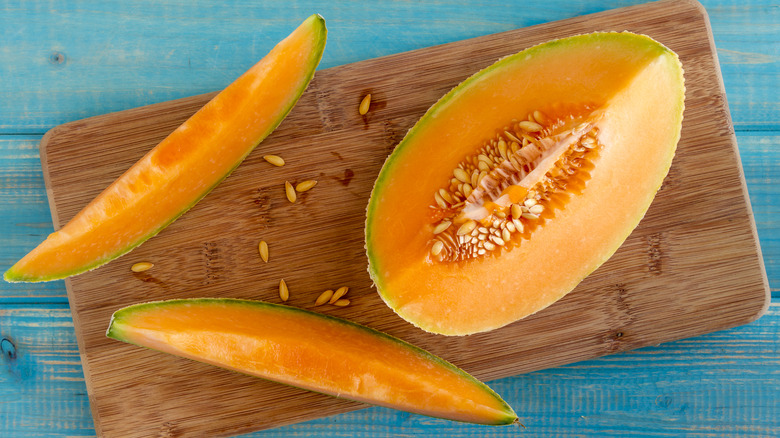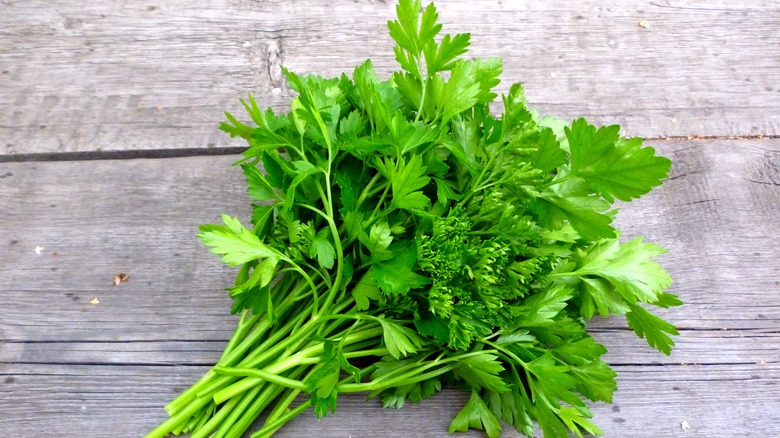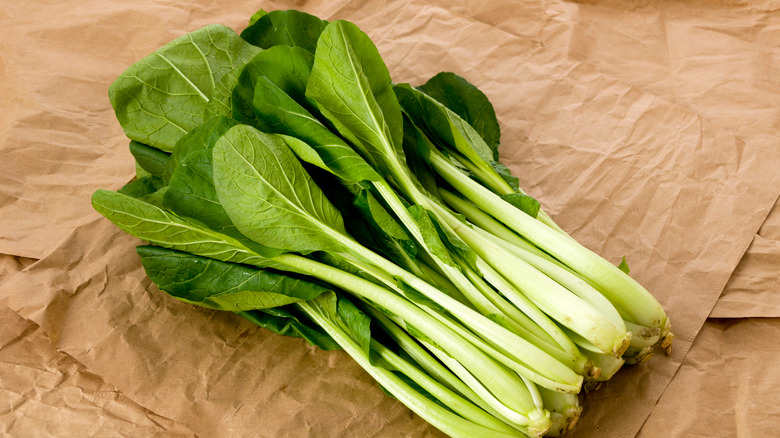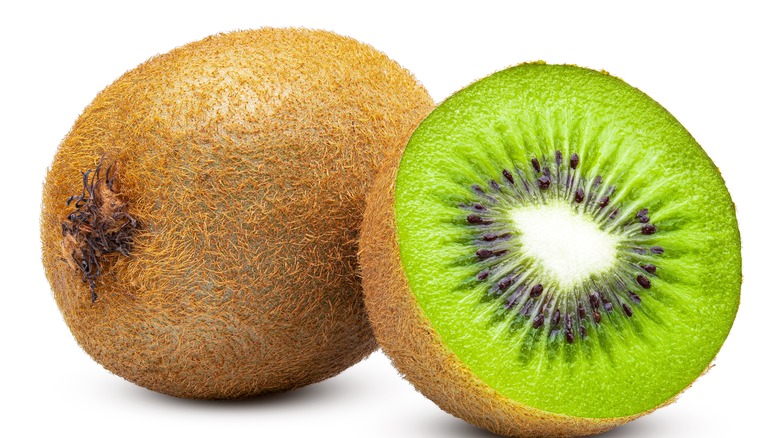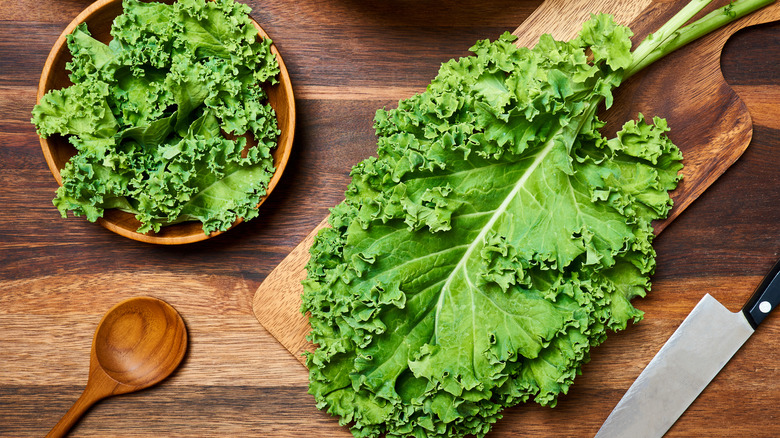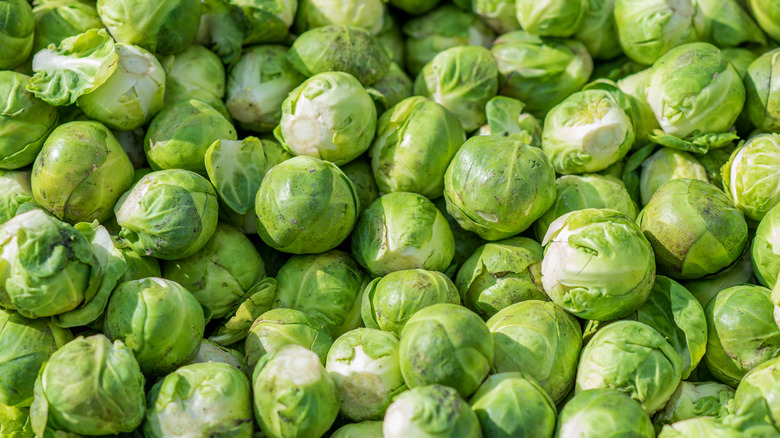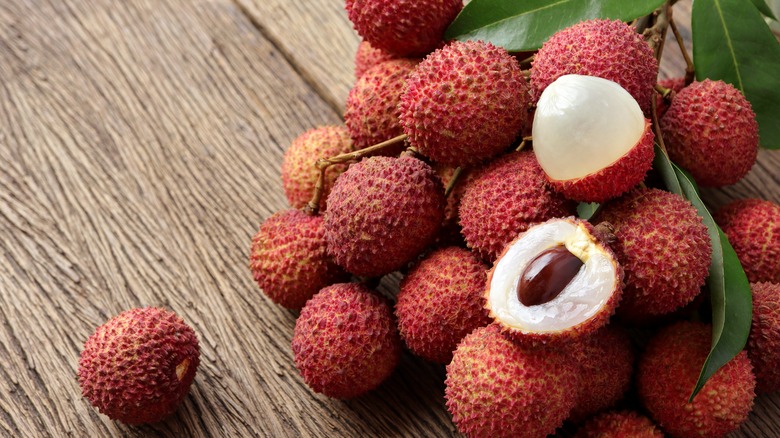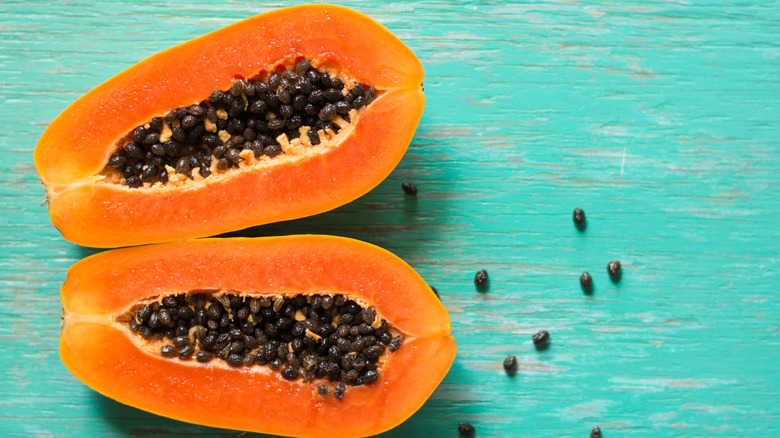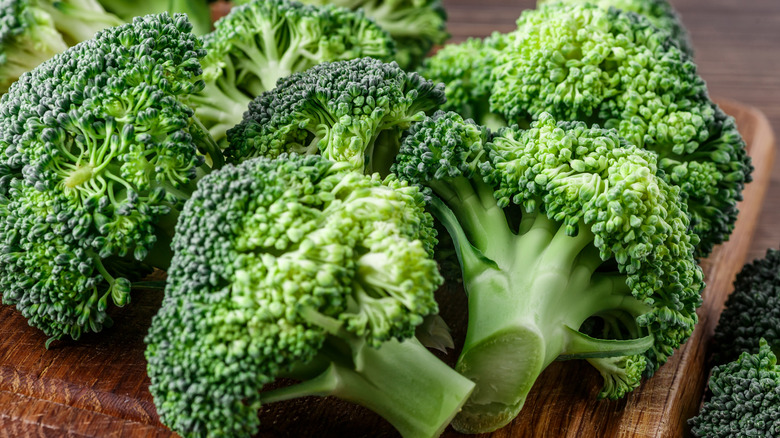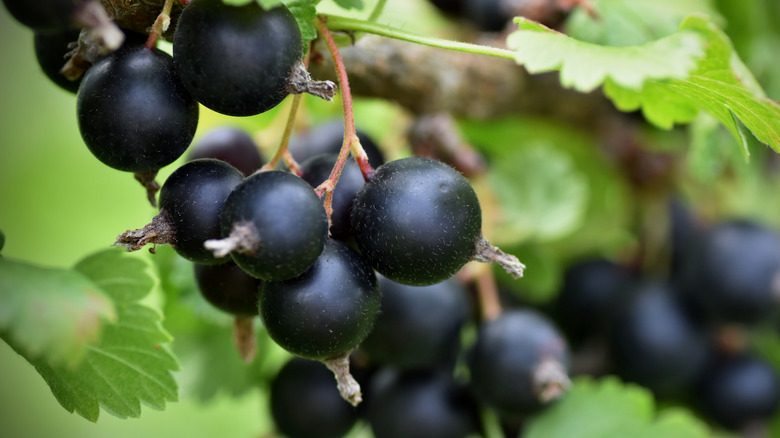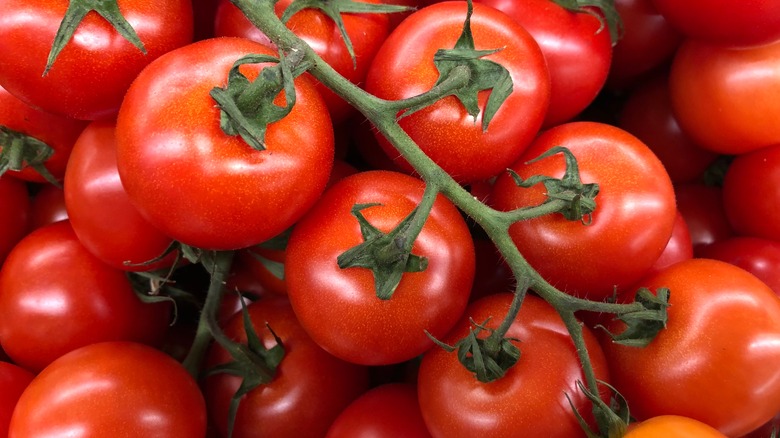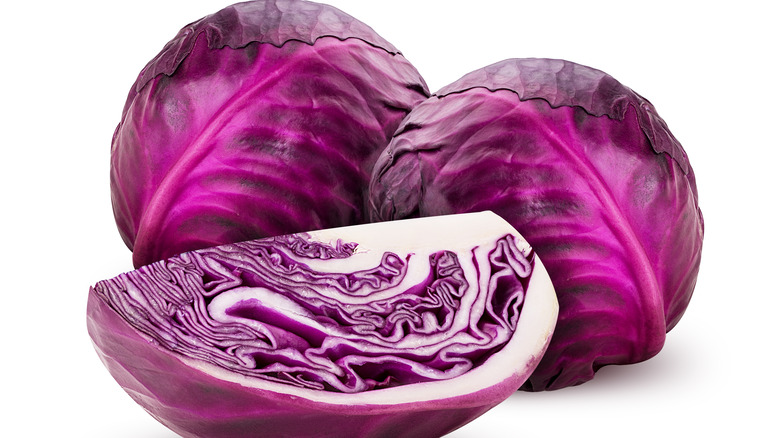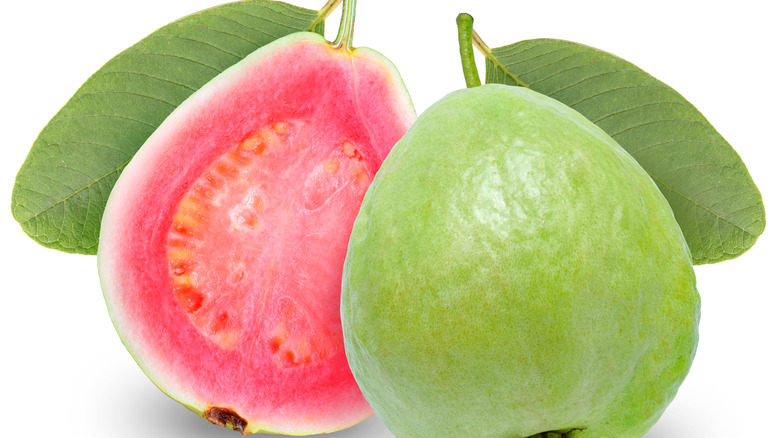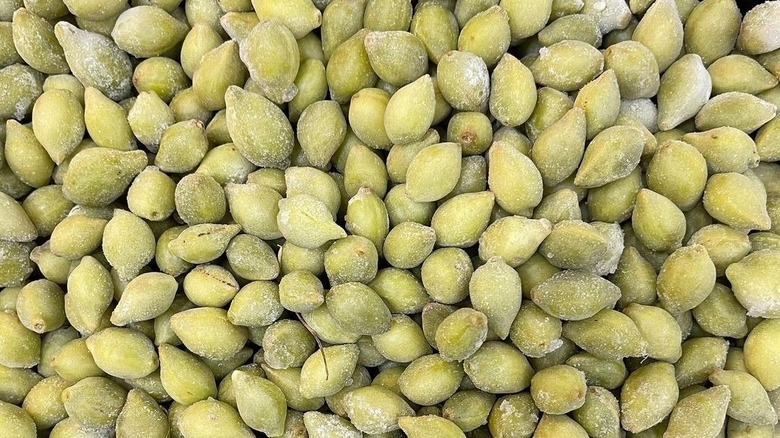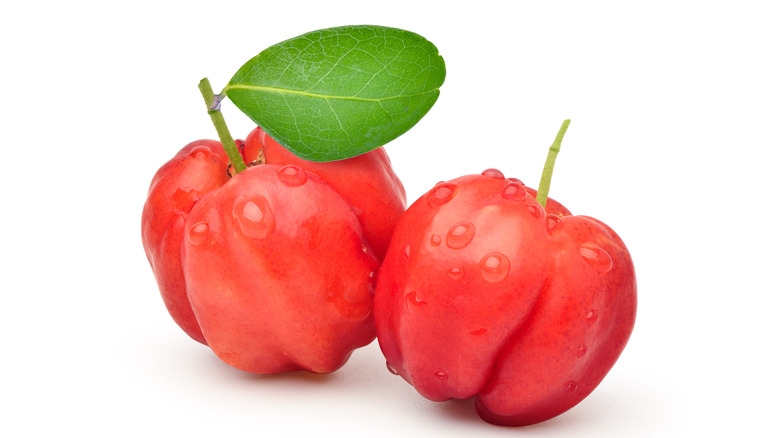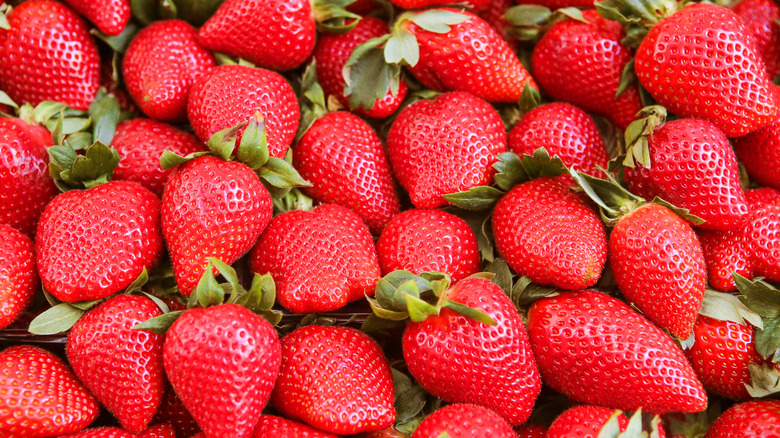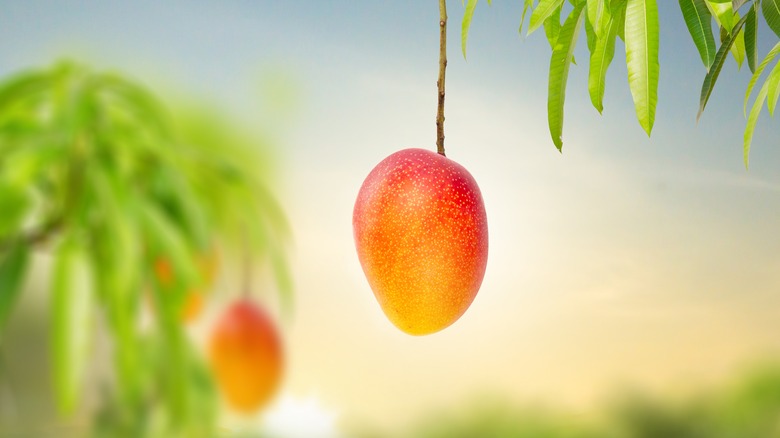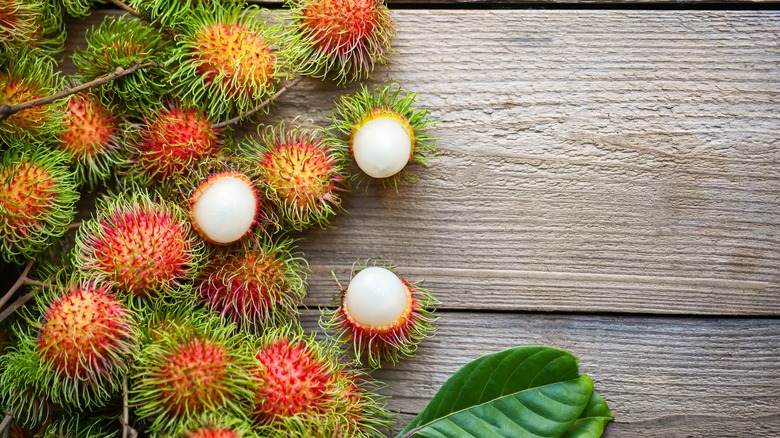20 Unexpected Foods That Add More Vitamin C To Your Diet
Vitamin C is an important antioxidant that is essential to a healthy diet. It works to strengthen bones, repair tissues, form collagen, protect teeth, and plays a key role in boosting your immune system. Because it is an antioxidant, it can protect against free radicals that can damage your hair, skin, and overall health. It is such an important vitamin that experts recommend consuming vitamin C every single day. Since vitamin C has so many health benefits, it's surprising that 39% of American adults are not getting enough vitamin C in their diet (via Rupa Health).
Lacking vitamin C in your diet affects overall health from your teeth to your toes. Without enough vitamin C, your immune system is compromised, leading to all sorts of health issues. In addition, you are at higher risk of iron deficiency since vitamin C helps the body absorb iron.
So, how do you get more vitamin C in your diet? Of course, everybody knows oranges and other citrus fruits are high in vitamin C. Still, many don't know that other fruits and vegetables are chock full of this essential vitamin. If you want to add more vitamin C to your diet to protect your health and boost your immune system, look for ways to get more of these fruits and veggies onto your daily menu.
Sweet red, orange, and yellow peppers
Sweet red, orange, and yellow bell peppers are excellent sources of vitamin C. According to Healthline, these colorful, crunchy peppers provide more than 100% of the recommended daily amount of vitamin C. If you are new to cooking bell peppers, there are many great ways to add them to your diet. You can make fajitas, throw them in a stir fry, stuff them with rice, or add them to a crudité platter.
If you are wondering why green peppers are left out, it's because green peppers contain only half the amount of vitamin C as the other peppers (via Science Explorer). So while green peppers are still a healthy option, if you are looking for the most vitamin C, choosing the riper colorful peppers is the best option.
Rose hips
Rose hips are an excellent source of vitamin C, with 426 milligrams per 100 grams, per Nature Claim. But you may be wondering, what exactly are rose hips? They are the fruit of the rose plant and look like little red bulbs. These bulbs are filled with seeds and located below the rose petals.
While you won't find rose hips in the produce section, you can still add them to your diet. Adding them to your diet is as easy as boiling water; rose hip tea is one of the best ways to ingest these sweet fragrant bulbs and is available at most markets.
If you have roses in your garden, you can harvest them yourself by cutting the small bulbs when they are ripe and removing the seeds. Once cleaned, you can use them like cherries or apricots in jams and desserts. A word of caution: Before you harvest your or your neighbor's rose plants, ensure that they haven't been exposed to chemicals or pesticides.
Cantaloupe
Cantelope is a fruit in the melon family that has a sweet smell and delicate flavor. It's a versatile fruit that can be eaten on its own, in a fruit salad, blended in a smoothie, or served with prosciutto as an appetizer. While they are available year-round, they are best in the summer months.
Eating cantaloupe is a great way to get more vitamin C in your day because one cup has over the recommended daily dose of vitamin C, per Healthline. Even the seeds are nutritious and filled with essential vitamins; surprisingly, cantaloupe seeds are also an excellent source of protein. The best way to add cantaloupe seeds to your meals is to use them as you would other types of seeds; you can toast them as a salad topper or blend them in purees and sauces, or roast them with salt and eat them by the handful to be sure you get your daily supply of vitamin C.
Parsley
Parsley, the popular leafy green herb, is more than just a decorative garnish and flavorful herb; it's actually a nutritional powerhouse with impressive health benefits. According to Healthline, parsley is rich in antioxidants and has significant amounts of vitamins A and K, and it contains over half of the recommended daily amount of vitamin C per half cup.
So how can you get a half cup of parsley in your diet? Well, eating this grassy herb by itself may not appeal to everyone, but adding it to chutneys or sauces like chimichurri or pesto is the best way to up your parsley intake to take advantage of its health benefits. So add more green to your diet with parsley; just watch out for it getting stuck in your teeth.
Mustard greens
You are probably familiar with mustard, the bright yellow sandwich spread. But you may not be familiar with mustard greens, the plant that provides the seeds to make mustard. Mustard greens can be found in most grocery stores and have a peppery, bright flavor. The thin leaves are similar to spinach but have an almost spicy tanginess reminiscent of arugula. While they are in the same Brassica family as collard greens and kale, they are not as dense and bitter. Instead, they have an intense flavor with a light texture.
Mustard greens were traditionally used medicinally as a topical antiseptic for cuts and abrasions; nowadays, they are a part of a healthy diet with more vitamin C than oranges and a host of other vitamins and minerals (via WebMD). They are a versatile green and easy to prepare. You can sauté them in butter or braise them in vinegar; the possibilities are endless.
Kiwi
Kiwis, the ugly fuzzy brown fruit with a sweet surprise inside, are the perfect way to get more vitamin C. While they aren't much to look at, once you slice them open and get a taste of the bright green fruit with the tiny black seeds, you will be hooked. They are sweet and tart, like a mix between a berry and a pineapple but with a softer texture. They make an excellent sweet treat for healthy eaters. According to Healthline, just one kiwi will provide 80% of the daily recommended dose of vitamin C.
Kiwis were previously considered an exotic fruit, but they have grown in popularity and are now readily available in most major grocery stores. They are a great addition to a fruit salad or fruit smoothie. And thanks to their tartness, they work well in marinades and salad dressings, too.
Kale
Kale gets a bad rap. Yes, it was the media darling a few years ago, and chefs were adding it to everything from lasagna to smoothies, even making salty chips with it, but then it lost its luster and became the butt of jokes about healthy eating. But it really does deserve the spotlight as a nutritious leafy green. After all, it boasts protein, fiber, calcium, essential vitamins, and iron. So, the media attention to kale wasn't just hype. Just one cup of raw kale provides all of the vitamin C you need for the day (via My Fitness Pal).
Of course, not everyone is a fan of kale. It is tough and slightly bitter and can be challenging to add to your diet. If you are new to preparing kale at home, you will want to avoid some of the common mistakes that home chefs make when preparing kale. When cooking with kale, you can use it like spinach. But when preparing kale to eat raw in a salad, you will want to use your hands to massage the kale to break down the thick leaves, and you should always remove the spine to make it more palatable.
Brussels sprouts
Brussels sprouts, probably one of the most hated vegetables in the U.S., are making a comeback and have been given a second chance to win over reluctant diners. A Dutch scientist found a way to remove the chemical compound that gave Brussels sprouts their unpleasant bitter taste making them more palatable (via NPR). This is great news for healthy eaters because Brussels sprouts have too many health benefits to be left off your plate.
Medical News Today reports that Brussels sprouts are low in calories and high in fiber, with an abundance of vitamins and minerals. One cup of Brussels sprouts will provide you with almost your full daily dose of vitamin C. It's hard to believe these tiny little cabbage-looking vegetables have so many health benefits; good things really do come in small packages. The best way to get the most flavor out of these gems is to roast them long enough to make them soft but not too long before they lose their texture.
Lychees
Lychees are tropical fruit grown in parts of China and Southeast Asia. They have a tough red outer shell and a soft white juicy middle. The red shell and the dark seed are inedible, but the soft white fruit is sweet and perfect for desserts and juices. In many parts of Asia, it's common to see mounds of fresh lychees in the market, and lychee-flavored soft drinks and sweets are local favorites.
If you have never tried lychees, you can look for them in specialty grocery stores and international markets. They are definitely worth seeking out because not only are they sweet like a natural candy, they are packed with health benefits, including being high in vitamin C. According to Proactive Health Labs, 10 lychees have the same amount of vitamin C as a medium orange.
Papayas
Papayas are an oblong tropical fruit grown from a tree that resembles a palm tree. They are believed to originate from southern Mexico, where they are often eaten with sprinkles of chili powder, per Frontiers in Ecology and Evolution. While the tough outer skin is inedible, the bright orange fruit is a breakfast staple in Latin America. And the round bitter black seeds are consumed for medicinal purposes.
Papayas are a delicious way to add more vitamin C to your day. According to Healthline, one medium papaya provides more than the daily recommended dose of vitamin C.
If you love Thai food, you may have tried green papaya in a popular Thai salad. Green papaya is just unripe papaya and is not as sweet as ripe orange papaya. It has a mild flavor and crunchy texture, and it's commonly used like jicama or cucumbers in savory salads.
Broccoli
It's no surprise that broccoli is a healthy addition to your dinner plate. The green cruciferous vegetable is a go-to for those looking to clean up their diet. It is readily available, versatile, and easy to prepare. While you can roast, steam, microwave, grill, and even boil broccoli, the best way to prepare it to maintain all of its nutritional value is to steam or blanch it (via American Institute for Cancer Research).
Surprisingly, broccoli has more vitamin C than oranges. According to Heal With Food, eating one cup of raw broccoli has enough vitamin C to meet your daily requirement; compare that to a medium-sized orange which only has a little more than half of the daily requirement. But be warned, broccoli can cause gas and bloat, so keep that in mind and avoid it on date night.
Black currants
Black currants are small dark edible berries commonly used in jams, teas, and desserts. They haven't been widely used in the U.S. and were even banned at the turn of the century until recently because they were responsible for a harmful fungus that is detrimental to pine trees (via Fruit Smart).
Luckily, these tart little berries are no longer banned and are starting to make a comeback in the culinary scene, which is excellent news because they are tasty and highly nutritious. WebMD shares that one serving of black currants provides 85% of your daily vitamin C needs, along with other health benefits. The entire plant has medicinal properties, from the leaves to the seeds, so while you may not have seen many of these berries in the market, their extracts, tinctures, and seed oil are popular supplements.
Tomatoes
Tomatoes, the humble red fruit that we use as a vegetable, are full of antioxidants. They are another super source of vitamin C and the antioxidant lycopene. According to Healthline, just one medium tomato has 28% of the recommended daily dose of vitamin C. The other important antioxidant found in tomatoes is lycopene. Lycopene is abundant in tomato skin and responsible for its bright color. Luckily, to get the health benefits from lycopene, tomatoes can be either cooked or raw.
Interestingly, when you cook tomatoes, the vitamin C level is lowered through the cooking process, but the lycopene level goes up. Conversely, raw tomatoes have more vitamin C but lower levels of lycopene. So whether you prefer your tomatoes raw in a Caprese salad or simmered down into a sauce, you will be getting plenty of antioxidants.
Red cabbage
Red cabbages are actually more purple than red and are one of the most underrated vegetables. Sure, they look neat when sliced open with their intricate patterns, but they are more than just a pretty color; they are incredibly nutritious. From fiber to folic acid, this colorful vegetable has it all. You can eat them for better digestion, a healthy heart, or to get vitamin C. Red cabbage provides a whopping 54% of your daily dose of vitamin C in just one cup, so make sure to add more of this crunchy cruciferous to your plate if you're looking to up your vitamin C intake (per WebMD).
You can use red cabbage to make more than just coleslaw. Try sautéing them with noodles or pickling them for a tangy taco treat. They are such an excellent addition to a balanced diet.
Guavas
Guavas are tropical fruit originally from Mexico and Central America regions. Now, they are abundant in other tropical climates like Malaysia and the Caribbean. Guavas are small and can be pinkish to yellow; the different varieties of guava range from super sweet to less sweet, making them a popular fruit to make into juice. If you have ever vacationed in Mexico or the Caribbean, chances are you have had guava juice. And if you haven't ever had it, then you should start now. Just one of these cute little fruits has more vitamin C than an orange; they pack two doses of your recommended daily dose of vitamin C (via WebMD).
You can find guavas near the other tropical fruits in your local market. And if you aren't a fan of the flavor or can't find them in your local store, you can try guava leaf extract, which is more readily available and can be applied topically for healthy skin and the guava glow. According to the Times of India, guava can help skin damaged by sun exposure and the natural aging process by replenishing skin cells.
Kakadu plums
Over the years, Australia has given the world many gifts, including vegemite, meat pies, and the Hemsworth brothers, and now they have another yummy gift to offer; the kakadu plum. The kakadu plum, native to Australia, is considered a superfood because it is the fruit with the most vitamin C in the world. One kakadu plum, which is roughly the size of a golf ball, is believed to have over 3,000 times the daily recommended dose of vitamin C (via Healthline). But don't worry, you can't overdose on vitamin C because it's a water-soluble vitamin, meaning too much will just flush out of your system.
Luckily, you don't have to take a trip to the land down under to try these tart little fruits: You can find them in most major grocery stores. While they are tasty on their own, you can also use them like you would other fruits and make jellies, jams, and desserts.
Acerola cherries
Sometimes called Barbados cherries, acerola cherries are a sub-tropical fruit with a tart flavor and a high vitamin C content. Just one ounce of acerola cherries has 783% of the recommended daily intake, per SuperFood Evolution.
In the Caribbean, these small red treasures are used to make sweets, desserts, and skin care products. According to Forbes, Barbados native, and international superstar, Rihanna has a skin line, Fenty, that prominently features acerola cherries. They are so good for you that you can eat them or just slather them on your skin and reap all of the benefits of these potent little balls of goodness.
If you can't find this unique superfood in the produce section, try combing through the powders and supplements in the health food section. Several companies offer acerola cherries in powder and vitamin form.
Strawberries
While you might associate strawberries with sugary decadent desserts and homemade ice cream, they can do double duty and be a part of a healthy diet. SF Gate reports that to meet your daily vitamin C intake, you only need to eat five strawberries, which is pretty amazing since, for many, a small basket is a serving size.
Strawberries aren't just for those with a sweet tooth; you can add strawberries to savory dishes, too. Fresh strawberries can add another layer to a simple green salad or pair them with chicken and avocado for a savory summer dish.
Like most berries, strawberries tend to go bad quickly. So to help them last longer, only wash them as you use them and store them in an airtight container in a single layer.
Mangoes
Sweet juicy mangoes, the tropical fruit that has gained a following in the U.S., are filled with vitamins and minerals. The bright orange fruit is easily found in most produce sections. You can also find bags of frozen mangoes in the freezer section, perfect for smoothies. Dried mangoes are also readily available and great for snacking.
One cup of cut mango provides half of your daily vitamin C, and at only 50 calories is a great snack for those watching caloric intake, per My Fitness Pal. With all of the amazing health benefits that mangoes have to offer, it can't hurt to eat them regularly.
Mangoes aren't just for satisfying a sweet tooth; you can add them to savory recipes too. Try adding mangoes to spicy salsa, bland white fish, or grilled pork for an extra kick.
Rambutan
The spiky little red fruit that resembles a sea urchin is a good source of vitamin C. While not common in American grocery stores, rambutans can be found in international markets. They are a fun-looking fruit about the size of a golf ball and have a spiky inedible exterior, but inside there is a white, sweet gelatinous fruit and an inedible seed. They are similar to lychees but sweeter.
Rambutans are a popular fruit in Southeast Asia and Latin America, where they are consumed for their taste and health benefits. They are a great source of fiber and are often used for weight loss and given to those with digestive issues. Just a handful of rambutans, about five to six, have half of the daily dose of vitamin C (via Healthline).
